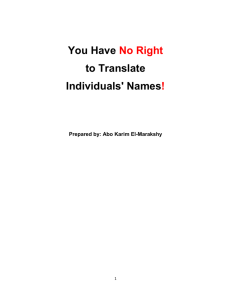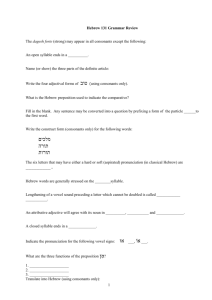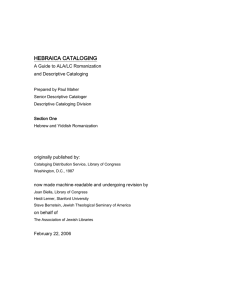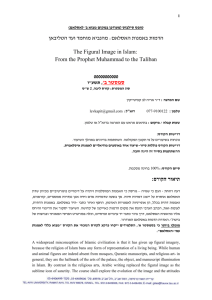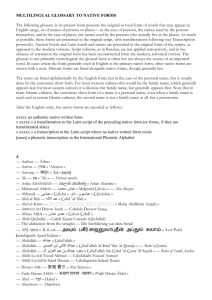Notes
advertisement
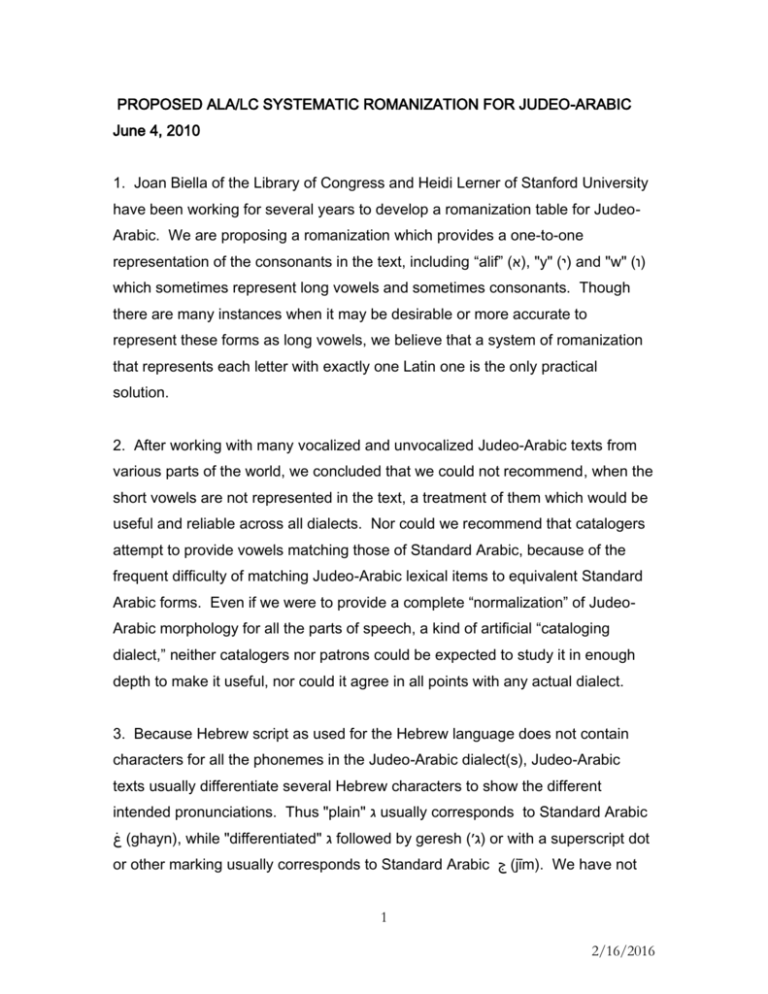
PROPOSED ALA/LC SYSTEMATIC ROMANIZATION FOR JUDEO-ARABIC June 4, 2010 1. Joan Biella of the Library of Congress and Heidi Lerner of Stanford University have been working for several years to develop a romanization table for JudeoArabic. We are proposing a romanization which provides a one-to-one representation of the consonants in the text, including “alif” ()א, "y" ( )יand "w" ()ו which sometimes represent long vowels and sometimes consonants. Though there are many instances when it may be desirable or more accurate to represent these forms as long vowels, we believe that a system of romanization that represents each letter with exactly one Latin one is the only practical solution. 2. After working with many vocalized and unvocalized Judeo-Arabic texts from various parts of the world, we concluded that we could not recommend, when the short vowels are not represented in the text, a treatment of them which would be useful and reliable across all dialects. Nor could we recommend that catalogers attempt to provide vowels matching those of Standard Arabic, because of the frequent difficulty of matching Judeo-Arabic lexical items to equivalent Standard Arabic forms. Even if we were to provide a complete “normalization” of JudeoArabic morphology for all the parts of speech, a kind of artificial “cataloging dialect,” neither catalogers nor patrons could be expected to study it in enough depth to make it useful, nor could it agree in all points with any actual dialect. 3. Because Hebrew script as used for the Hebrew language does not contain characters for all the phonemes in the Judeo-Arabic dialect(s), Judeo-Arabic texts usually differentiate several Hebrew characters to show the different intended pronunciations. Thus "plain" גusually corresponds to Standard Arabic ( غghayn), while "differentiated" גfollowed by geresh ( )ג׳or with a superscript dot or other marking usually corresponds to Standard Arabic ( جjīm). We have not 1 2/16/2016 tried to represent all the possibilities for "differentiation" in Judeo-Arabic texts in our table, intending that whichever common one(s) we have chosen to cite may stand for any of the others. 4. If the text to be romanized is vocalized with Tiberian Hebrew vowel points, we propose that the full text with vowels be represented in the transcribed fields of the bibliographic record (245, 250, 260, 4XX), and that a 246 “variant title” field be added to such records with the consonantal romanization of the 245╪a as provided in this table. 5. When Hebrew words or phrases are embedded in a Judeo-Arabic context, we propose that they be romanized in Judeo-Arabic style--that is, without short vowels and with Judeo-Arabic consonantal values (thus /Hgdh šl Fsḥ/ not /Hagadah shel Pesaḥ/). An independent string of Hebrew words, e.g., in the title proper of a work, may be romanized as Hebrew, but we recommend adding a 246 giving the Judeo-Arabic consonantal transcription: 245 10 Sefer Ṿa-tagid li-vene Yiśraʼel 246 3 Sfr W-tgyd l-bny Yśrʼl For romanizing Hebrew text with vowels, including abbreviated honorifics or religious formulae, use the guide to ALA/LC Hebrew romanization prepared by Paul Maher in Hebraica Cataloging (Washington, D.C. : Cataloging Distribution Service, Library of Congress, 1987); online edition, slightly revised, http://wwwsul.stanford.edu/hebraicafunnel/ Hebraica_Cataloging_Manual/ Hebraica%20Cat%20Manual%20Feb%202006%20Draft.pdf. והווא ספר אליהו הנביא ז"ל w-hwwʼ sefer Eliyahu ha-Navi, zal יצ"ו,החכם כמהר"ר יהודה שתרוג he-ḥakham k. mo. ha-r. R. Yehudah Śitrug, y. ts. ṿ. 2 2/16/2016 6. In cases where it is possible, that is when the Judeo-Arabic consonants of the text can be matched with a Standard Arabic interpretation, a 246 “variant title” field in Standard Arabic can be provided for additional access. Narrative texts in particular may have standard Arabic titles and may indeed be direct adaptations of standard Arabic originals. 7. Name authority work presents a problem when specifically Judeo-Arabic names are involved—e.g., the forename /Mqyqṣ/. We propose to keep an online list of found romanizations and code such headings (romanized as seems reasonable) “provisional” until they can be added to the list of authorized forms. Robert Attal’s ”ha-Sifrut ha-ʻArvit-ha-Yehudit be-Tunisyah : meʼah shenot yetsirah (1861-1961) : tsiyunim bibliyografiyim” (Yerushalayim: Mekhon Ben-Tsevi leḥeḳer ḳehilot Yiśraʼel ba-Mizraḥ, 2007) provides a name index to Tunisian authors that includes French forms as they appear on added title pages. This may serve as a tool to establish forms for authors such as: חיים,בשירי = Bsiri, Haïm, not Bashiri, Hayim. 7. Hebrew or Standard Arabic forenames and surnames should be established according to the rules in AACR2 and the LCRIs for those languages, and references in systematic ALA/LC Judeo-Arabic romanization should be provided. 8. Please address comments or questions on this romanization table to Joan Biella at jbie@loc.gov or to Heidi Lerner at lerner@stanford.edu. 3 2/16/2016 Proposed ALA/LC Judeo-Arabic Romanization Table (Draft, June 2, 2010) Judeo- Roman Examples Arabic א ʼ אל/ʼl/ “the” אבן/ʼbn/ “son” ב, בּ b בנין/bnyn/ “sons” ארבע/ʼrb‘/ “four” ̣ג,ג g גרק/grq/ “he suffocates” (cf. Standard /ghariqa/) ḡ ג׳ינא/ḡynʼ/ “we came” (cf. Standard Arabic /jīnā/) ד d דם/dm/ “blood” (cf. Standard Arabic /dam/) דכרת/dkrt/ “she remembered” (cf. Standard Arabic /dhakarat/) ד׳ ḏ ד׳הב/ ḏhb/ “gold” ה h הום/hwm/ “they” ̈ה ḧ מדינ̈ה/mdynḧ/ “city (of)” ו w ואחד/wʼḥd/ “one” ארואח/ʼrwʼḥ/ “spirits” 4 2/16/2016 וו ww כוואכב/kwwʼkb/ “stars” נבווא/nbwwʼ/ “prophecy” לוורא/l-wwrʼ/ “after, behind” ז z זוג׳תו/zwḡtw/ “his wife” ח ḥ חייאת/ḥyyʼt/ “life” בחר/bḥr/ “sea” ט ṭ טול/ṭwl/ “length” עטא/‘ṭʼ/ “he gave” ̇ט ẓ ̇טהר/ẓhr/ “he appeared” י y יד/yd/ “hand” ביות/bywt/ “house” ידי/ydy/ “my hand” יי yy אייאם/ʼyyʼm/ “days” לייג׳יב/l-yyḡyb/ “that he may bring” רג׳ליי/rḡlyy/ “my (two) feet” כ ך, כ, ךּ,ּכ k ּכאנת/kʼnt/ “she was" ד׳אלךּ/ḏʼlk/ “that” כבז/kbz/ “bread” (cf. Standard Arabic /khubz/) ל l לייאלי/lyyʼly/ “nights” 5 2/16/2016 ם,מ m מן/mn/ “from” אסם/ʼsm/ “name” ן,נ n נפס/nfs/ “soul” בין/byn/ “between” ס s סמע/sm‘/ “he heard” יסראיל/Ysrʼyl/ “Israel” ע ‘ עביד/‘byd/ “servants” ף,פ ף ׳,פ ׳ f פי/fy/ “in” צ ṣ צנע/ṣn‘/ “he did” ץ׳,צ׳ ṣ̄ ארץ׳/ʼrṣ̄/ “earth” (cf. Standard Arabic /arḍ/) צ׳אלם/ṣ̄ʼlm/ “wicked” (cf. Standard Arabic /ẓālim/) ק q קאל/qʼl/ “he said” מקדס/mqds/ “holy” ר r רבי/rby/ “rabbi” (lit., “my lord”) ש,שׁ š שעב/ š‘b/ “nation” משרק/mšrq/ “east” שׂ ś ישׂראל/Yśrʼyl/ “Israel” (only in Hebrew loan words) ת,תּ t תּקול/tqwl/ “you say” 6 2/16/2016 סבתּ/sbt/ “Sabbath” with no diacritic, the character /ת/ may correspond etymologically with Standard Arabic /ث/ /th/, e.g., in מתל/mṯl/ “proverb” Ligature ﭏ initial: ʼl ﭏ/ʼl/ “the” מﭏ/mʼl/ “property” Notes (Numbered examples below from Robert Attal’s ha-Sifrut ha-ʻArvit-ha-Yehudit be- Tunisyah : meʼah shenot yetsirah (1861-1961) : tsiyunim bibliyografiyim, Yerushalayim: Mekhon Ben-Tsevi le- ḥeḳer ḳehilot Yiśraʼel ba-Mizraḥ, 2007.) 1. As in the ALA/LC romanization tables for (Standard) Arabic and Hebrew, follow all conjunctions and prepositions prefixed to other words with a hyphen in romanization: )523( ואבן w-ʼbn )222( קצת יוסף הצדיק qṣt Ywsf h-ṣdyq )552( בביאן b-byʼn 7 2/16/2016 cf. Standard Arabic /bi-bayān/ 2. The filing indicator in a 245 field beginning with the definite article /ʾl-l is set to 2 (the alif diacritic is not counted). )523( אלטיור ʼl-ṭywr 3. Doubled consonants (marked in Standard Arabic with the diacritical mark shaddah) are represented as doubled in Judeo-Arabic romanization only if the letter is printed twice in the source: )525( אלגדדאר אלכוואן ʼl-gddʼr ʼl-kwwʼn BUT: )627( חכאית מחמד ḥkʼyt Mḥmd cf. Standard Arabic /ḥikāyat Muḥammad/ 8 2/16/2016
